The Ghost that Refuses to Die
IN THE SPRING of 1918, seeking solitude for study and thought, I packed my faithful burro with a few necessities and a good supply of food and ascended the eastern slope of California's Palomar Mountains. In a small green tree-bordered valley near the mountain's east end, I set up camp.It was interesting country as well as beautiful. Not far from my campsite stood a small building which had served as one of San Diego County's first back-country postoffices. It was a 7x9 foot log cabin with chimney and fireplace and two slab-sided lean-to additions. A Mr. McQueen and his daughter, Nellie, had lived in the cabin, I discovered later, and one of the lean-to appendages had housed the postoffice which had been named "Nellie" in honor of its first postmistress.
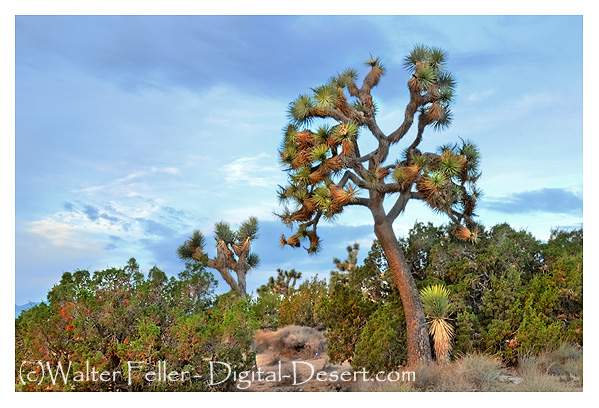
When chill autumn days came, 1 fixed up what was left of the place for temporary shelter. It took some ingenuity and a great deal of work to make it comfortable. The ground squirrels and gophers, entering through the rotted boards of the floor, had filled the place half with earth, and for years tall nettles had grown up through the openings that once were windows and doors. The stone chimney had fallen down and doors and windows were gone.
To keep out the wind and cold, someone who had formerly occupied the place had papered the walls several layers thick with copies of the San Diego Union, most of them bearing dates between 1882 and 1889. The not-too-good paste used to wed paper and wall had been made of wheat flour and water. Much of the paper had been nibbled by mice attracted by the nutritious flour-paste, or had peeled off. But luckily for me much still remained. Many interesting hours I whiled away lying on my make-shift bed, a platform of fir boughs, tearing off bits of paper and reading the news items of the information-filled wall covering. Even the advertisements made enticing reading, especially those promoting in pompous language the sale of new lands and building lots in California's young boom towns.
One of these was an appeal to lot buyers to purchase lands in the newly laid-out town of "Hesperia on the Mojave River, Denver of the West" and located like the famed Colorado metropolis on the broad sloping plain "just east of the big mountains" and with an "equally fine climate, minus the cold."
Hesperia was destined to develop into a fine city of several hundred thousand inhabitants, the advertiser claimed. Soon there would be hundreds of acres planted to peaches, apricots and vineyards of choice raisin grapes. Among other attractions there were to be broad streets, three parks, a new hotel, three stories high and built of "bricks burned on the spot" and the largest newspaper (The Hesperia Herald) in San Bernardino County! Moreover, the Atlantic and Pacific Railroad went right through the center of the town!
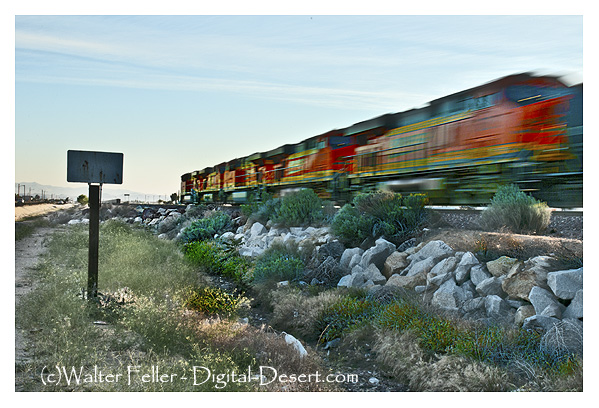
The ads aroused my curiosity. I was eager to see what had materialized of the loudly ballyhooed city-to-be, and before the following year was over I visited Hesperia, determined to learn all of its history.
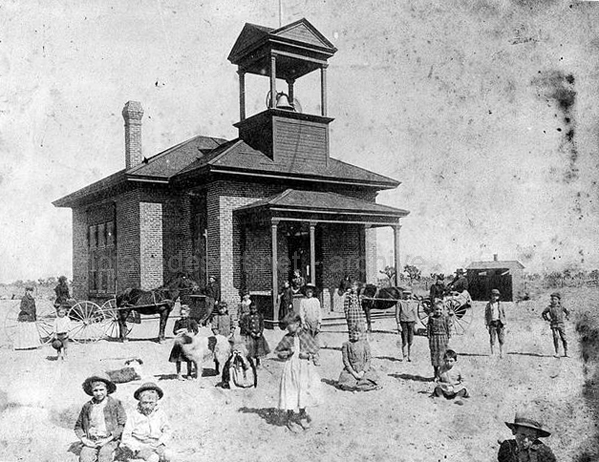
What I found in 1920 was certainly far from the Hesperia that was to have been. It was easy to see that the grand plans for the big city had never materialized. All I saw was a single store, a small railway station, a red brick schoolhouse, a few not-too-prosperous looking orchards and vineyards, six or eight houses much in need of repair and a large imposing box-like three-story building of red brick, the once much-advertised hotel and now the most imposing structure remaining.
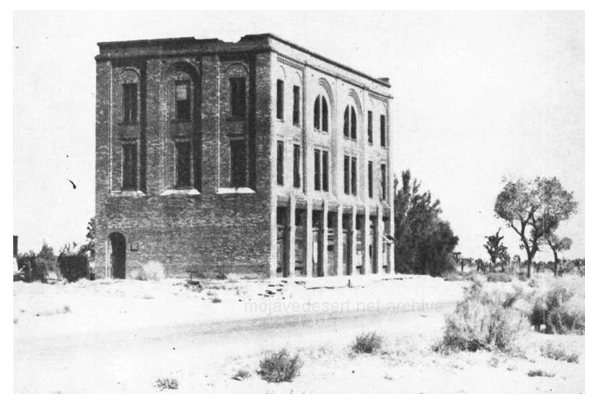
Hesperia Hotel -- Three-storied, 28-room hotel at Hesperia, ghost town in San Bernardino County, California. After several similar schemes failed, promoters are again ballyhooing the townsite. Their grandiose plans include making a museum out of the hotel
The big hotel of 28 guest rooms particularly interested me. After a long period of vacancy it recently had been repaired and reopened by two women who hoped to profit by the beginning surge of auto traffic over the newly improved "Old Trails Highway" between San Bernardino and Salt Lake City. Little did they suspect that only a few years later the new paved road to Victorville would by-pass Hesperia miles to the west, killing what little business the previous route had brought.
Mary F. Spencer, the botanist from Munich, had asked me to accompany her on a plant-collecting trip to Hesperia. She had engaged a room for me at the old hotel, a corner room on the third floor where I would have a grand view of the surrounding desert. I look back on it now as a most memorable day. I remember with pleasure the genial hostesses and the hotel's evening dinner of boiled whole potatoes, chipped beef and gravy, canned peas, homemade bread and country butter, and, for dessert, old-fashioned dried-apricot pie. For breakfast we were served ham and eggs, oatmeal with thick cream, stewed prunes, hot biscuits and honey, German fried potatoes and coffee. Simple meals they were, but well-cooked and graciously served.
At 7 o'clock next morning, a man driving a buckboard and two mules stopped in front of the hostelry and introduced himself as the guide the hotel managers had engaged to take us to "the very best flower fields anywhere to be found." He was a tall, lean, kind-mannered man with a Texas drawl. Of the numerous marvels of Texas we were constantly reminded. As he drove his mules along, and from time to time came to a particularly bright patch of flowers, he would suddenly draw up to a halt and exclaim: "O my, O my, O my, O my, O my, them's just like the purty flowers we had in Texas. Ain't them about the purtiest you ever did see?" There was no variation in his theme or in his manner of expressing it. It mattered not where we stopped nor what kind of flowers we saw, they were always "just like we had in Texas."
For several hours that evening Miss Spencer and I were busy sorting, pressing and labeling plants. Among our floral treasures was an unusually large form of Parish's beautiful pale blue larkspur (Delphinium parishii) which we had found growing among the Joshua trees just west of town. Down along the banks of the sandy dry bed of the Mojave River we had, by merest chance, come upon the rather rare short-statured yellow-flowered Palmer evening primrose (Oenothera palmeri) with its strange woody miter-shaped nutlets and thickish stems with papery peeling bark. The handsome blueflowered Great Basin sage also had attracted our attention. This beautiful shrub, growing often in thickets in among true sage brush and juniper, blooms during late April and the first three weeks of May. It is worth going many miles to see in flower.
On a windy winter day of 1925 I was offered a chance to rent all 28 guest rooms of Hesperia Hotel for $35 a month. It was unoccupied, and a man who posed as owner of the place tried to persuade me that it "would be a mighty profitable business" to use the upper floor for a bootlegging establishment. "I would tell nobody you was up there," he promised, "and a pretty profit you could make of it." I had two students with me and these the man took to be my sons. "Why, if [ had two sons like that I'd sure make a go of it. One could be hauling in grain and taking out the booze while you and the other boy could stay home and tend to the distilling."
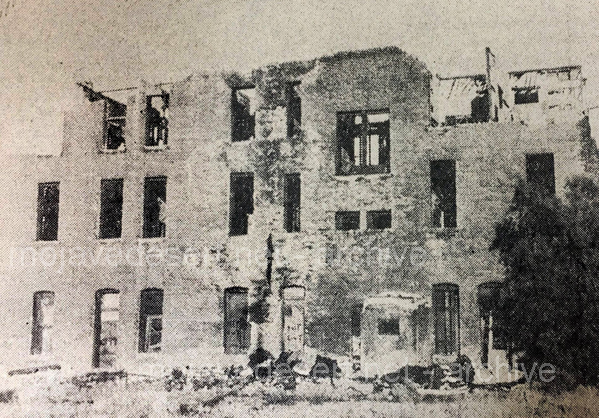
"But what if I got in trouble with the law?" I asked. To that question he had a ready answer. "If you got caught, mister, perhaps you might go to jail for six months, but your time wouldn't be wasted; for you could use all those long days thinking up a way to do your booze-making better next time. Mister, you'd better rent my hotel. There is no place like it for making good money quick."
Needless to say, the offer was turned down.
To get an accurate account of the history of Hesperia, I recently spent several days at the San Bernardino Courthouse looking into the old record books of the county surveyors and assessors office.
The records date back to July 10, 1869, when Max Stroebel acquired for $44,000, 35,000 acres of land from the United States Government Land Office. He turned it over on August 2, 1871, to a group of Germans from San Francisco who proposed to subdivide and colonize it.
In the following year, these lanes were taken over by the 35th Parallel Association with offices in San Francisco. It was really the same group of Germans associated under a new name. Their colonization plan never materialized, and on April 10, 1885, the Association sold out to Julius Finck. Six days later Finck sold out to a man named McNeil, who in the following year (May 6, 1886) sold out to the Hesperia Land and Water Company. This company was composed of the men who laid out the townsite of Ontario, California. Among them was B. M. Widney and the two Chaffey Brothers, George Jr. and William B.
Looking further into the old records I found that what had been tried in Ontario had been repeated in Hesperia. In giving title to the lands there was written in every deed the stipulation that if any liquor was ever sold, served or given away, even in the center of the streets in front of the land parcels, the title to the land would immediately pass back to the company.
According to an old map, this townsite as laid out by the Hesperia Land and Water Company consisted of about 40 blocks of 26 lots each, most of the lots measuring 25x142 feet.
These were offered for $50.00 and upwards apiece. In addition there were many 10.40 and 11 acre plots and many 22 and 25 acre lots—a grand layout indeed.
Water was brought in from Deep Creek in the San Bernardino Mountains via a seven-mile, 14-inch steel pipe which ended in a reservoir.
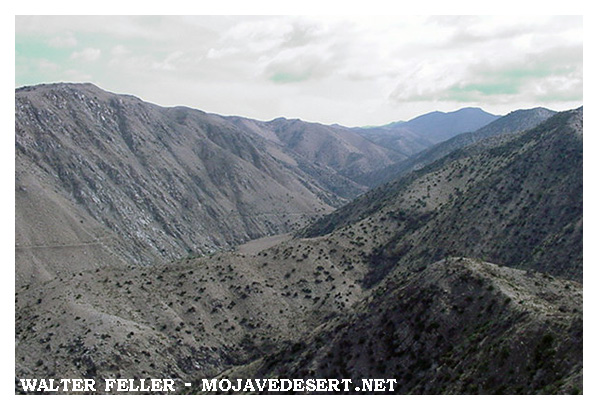
Known as the Hesperia Ditch this small aqueduct brought water from the tiny Lake Adelaide several miles up Deep Creek to an open reservoir seven miles away in what is now Lime Street Park.
After considerable land was sold, some of it to buyers as far away as England, a new company was formed to extend the boom. In the Los Angeles Herald of October, 1887, was reported: "One of the most important purchases of real estate ever recorded in Southern California was made yesterday afternoon by the following capitalists from New York: Lieutenant C. A. Barnes, S. A. Fleming and C. A. Smith, in connection with eminent capitalists from other parts of the country.
"The sale embraces the waters of the east fork of the Mojave, a cemented ditch four miles long and ten miles of steel and iron pipe for irrigation. The purchase includes the townsite of Hesperia, and the sold lands of the Hesperia company to be credited on the purchase, making the sum total of the purchase between one million and one million and a half of dollars.
"The purchasers will at once proceed to erect a hotel to cost $75,000 and a sanitarium to cost $25,000, the plans for which are already made.
"Fifteen miles of cement sidewalks will be made and half a dozen reservoirs constructed. A bank with a capital of $100,000 has also been decided upon. The new purchasers will spend about $750,000 in improvements making their outlay $2,000,000, but as they get 2,000 inches of water, valued at $1,000 per inch or $2,000,- 000 in the aggregate with 33,000 acres of land beside, and the California Central Railroad running through the tract, they feel exultant over their bargain. They will irrigate on the percolating principle practiced in Fresno with such satisfactory results and will enter upon raising deciduous fruits and the manufacture of raisins, which grow to perfection. It is understood that the margin put up yesterday was $200,000.00. The fruit planting on the purchased land will be on the largest scale ever started in the world, with a prospect of great profit. The company will have an electric light (sic) made by water power, of which they have a fall of 400 feet."
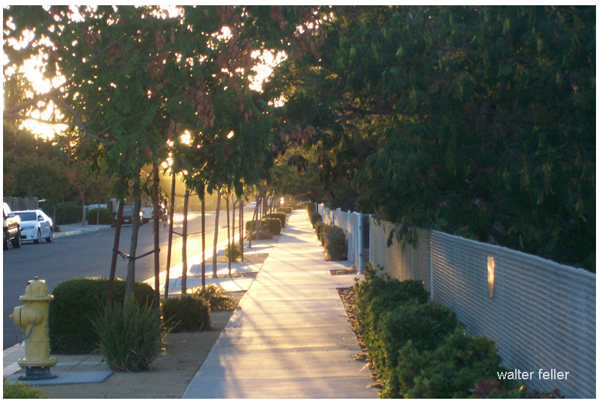
"Fifteen miles of cement sidewalks ... " - Modern day sidewalks in Hesperia
Hesperia now had its "second wind" but it was not to last. While everything seemed to be starting up fairly well, successive winter floods several times washed out the pipe line crossing under the river, and before it could be permanently repaired the young orchards and vineyards had suffered irreparable damage. Ranchers and townspeople became discouraged and left.
The lands in and around Hesperia reverted to desert and the site stands today much as it originally was. a broad plain covered by beautiful specimens of the giant tree Yucca (Yucca brevifolia). The old hotel, windowless and with most of its doors boarded up, seems the only reminder of the glory of Hesperia's past. Inside its walls may still be seen the remains of the grand staircase, the fireplaces, what is left of the "modern bathrooms with lead-pipe plumbing," the systems of speaking tubes that carried messages from floor to floor. But vandals have been there and until just recently it seemed certain that the grand hotel of the "Denver of the West" would be no more. But Hesperia is coming back again.
In mid-April of this year, the 35,000 acres of Hesperia property changed hands once more, passing into the ownership of the Hesperia Land Development Company. The promoters, including former world's heavyweight boxing champion Jack Dempsey, began to promise big things for Hesperia —artificial lakes (one to be 2Vi miles long), industry, agricultural development and residential buildings, a museum in the old hotel. They guessed they might spend as much as $8,000,- 000 on the project.
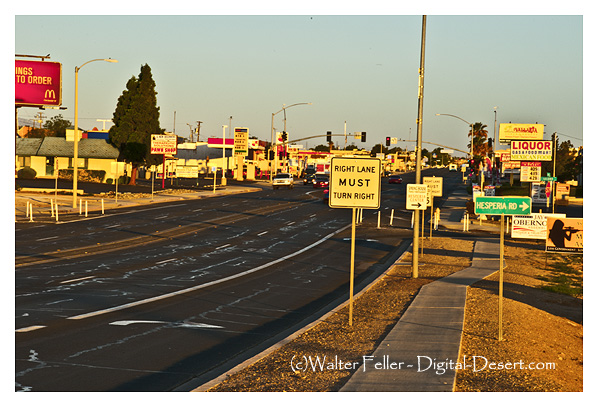
Perhaps something will come of it, perhaps not. To old timers, the news has a ring all too familiar—much talk, splashy newspaper publicity, some sales, and then a sudden collapse of the boom. It has happened more than once before. There still is hope that the Joshua tree forests will be allowed to live on undisturbed, unharmed by "development"; and the inhabitants of the quaint little village may carry on about as before, content to know that again "The Denver of the West" failed to materialize and that their desert home will remain unspoiled by the heavy hand of commercialism.
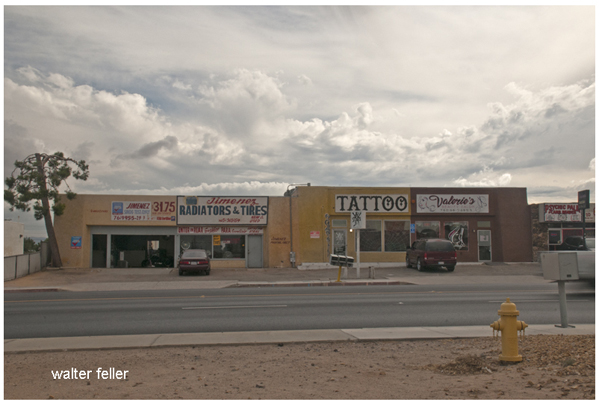
Curator of Plants
Riverside Municipal Museum
Sketches by the Author - Desert Magazine, August, 1954
Old-timers aren't particularly excited about the promise-packed promotion scheme underway since April at the ghost town of Hesperia, California. It has happened before. Several times in the past 75 years, promoters with plans just as grandiose and newspaper advertisements even gaudier have tried in vain to bring the town back to life. But maybe this time the never-say die ghost on the California desert will make the grade. Edmund Jaeger recalls his unique introduction to Hesperia in 1918, his early botanizing trips there and the town's history since.
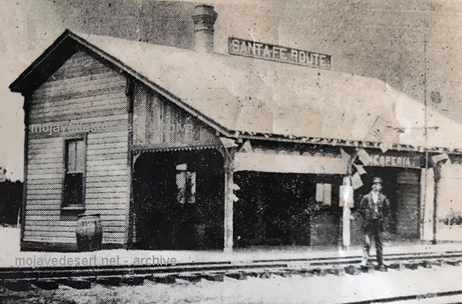
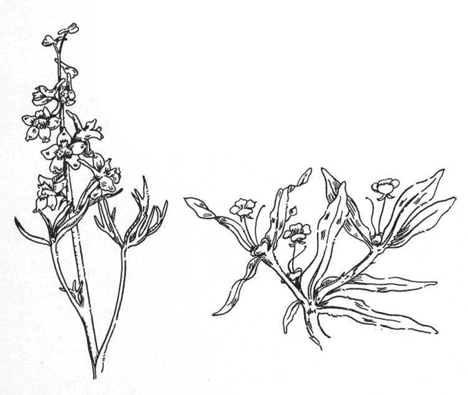
Parish Larkspur (I.) and Palmer Evening Primrose, two plant species the author found growing among the Joshua trees on the desert around Hesperia.
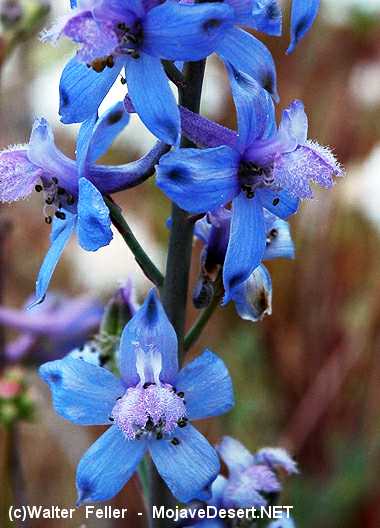
Parish Larkspur
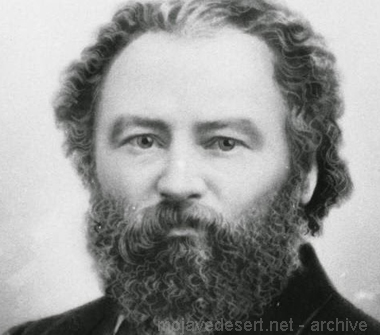
Anaheim residents only know him as the first mayor of Anaheim, but Maximilian Franz Otto Von Strobel came from an aristocratic family in Bavaria, was well educated, practiced in many trades and fields. He had a military background and was accused of being a spy for the British government which may have been the reason for his possible murder.
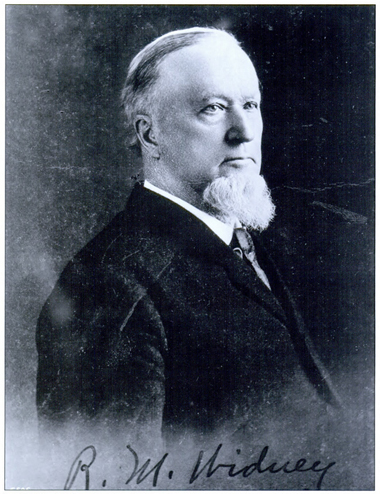
Robert MaClay Widney
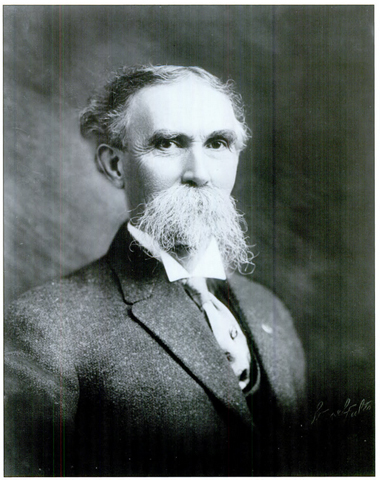
Joseph Palmaroy Widney
Hesperia Hotel 1887 - 1961
"It was shortly after Robert M. Widney purchased a large parcel of land soon to be called Hesperia that work on the Hesperia Hotel began. A magnificent structure for its day took over two years to build and was designed to stand approximately 45 feet tall, 40 feet deep and 65 feet long. It is estimated that over 40,000 handmade adobe bricks were used in the construction of the Hesperia hotel. ... "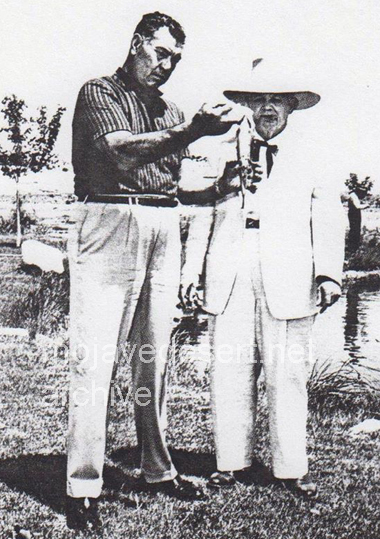
Jack Dempsey & Penn Phillips
